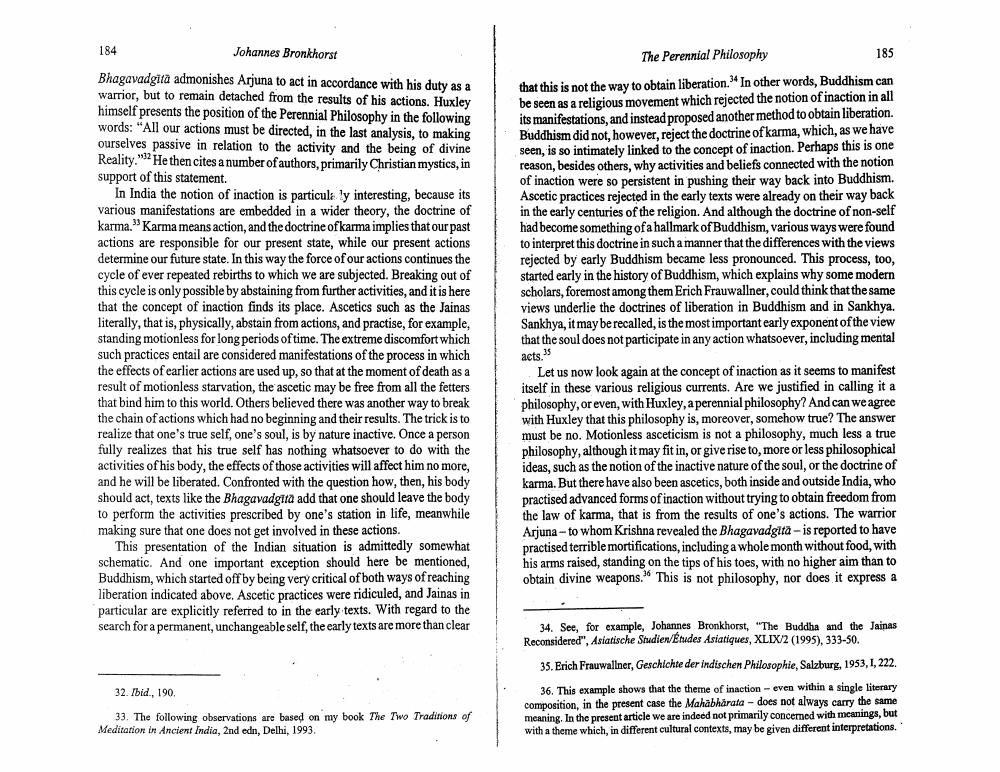Book Title: Perennial Philosophy And Law Of Karma Author(s): Johannes Bronkhorst Publisher: Johannes Bronkhorst View full book textPage 6
________________ The Perennial Philosophy 185 184 Johannes Bronkhorst Bhagavadgita admonishes Arjuna to act in accordance with his duty as a warrior, but to remain detached from the results of his actions. Huxley himself presents the position of the Perennial Philosophy in the following words: "All our actions must be directed, in the last analysis, to making ourselves passive in relation to the activity and the being of divine Reality." He then cites a number of authors, primarily Christian mystics, in support of this statement. In India the notion of inaction is particule ly interesting, because its various manifestations are embedded in a wider theory, the doctrine of karma." Karma means action, and the doctrine of karma implies that our past actions are responsible for our present state, while our present actions determine our future state. In this way the force of our actions continues the cycle of ever repeated rebirths to which we are subjected. Breaking out of this cycle is only possible by abstaining from further activities, and it is here that the concept of inaction finds its place. Ascetics such as the Jainas literally, that is, physically, abstain from actions, and practise, for example, standing motionless for long periods of time. The extreme discomfort which such practices entail are considered manifestations of the process in which the effects of earlier actions are used up, so that at the moment of death as result of motionless starvation, the ascetic may be free from all the fetters that bind him to this world. Others believed there was another way to break the chain of actions which had no beginning and their results. The trick is to realize that one's true self, one's soul, is by nature inactive. Once a person fully realizes that his true self has nothing whatsoever to do with the activities of his body, the effects of those activities will affect him no more, and he will be liberated. Confronted with the question how, then, his body should act, texts like the Bhagavadgita add that one should leave the body to perform the activities prescribed by one's station in life, meanwhile making sure that one does not get involved in these actions. This presentation of the Indian situation is admittedly somewhat schematic. And one important exception should here be mentioned, Buddhism, which started off by being very critical of both ways of reaching liberation indicated above. Ascetic practices were ridiculed, and Jainas in particular are explicitly referred to in the early texts. With regard to the search for a permanent, unchangeable self, the early texts are more than clear that this is not the way to obtain liberation. In other words, Buddhism can be seen as a religious movement which rejected the notion of inaction in all its manifestations, and instead proposed another method to obtain liberation. Buddhism did not, however, reject the doctrine of karma, which, as we have seen, is so intimately linked to the concept of inaction. Perhaps this is one reason, besides others, why activities and beliefs connected with the notion of inaction were so persistent in pushing their way back into Buddhism. Ascetic practices rejected in the early texts were already on their way back in the early centuries of the religion. And although the doctrine of non-self had become something of a hallmark of Buddhism. various ways were found to interpret this doctrine in such a manner that the differences with the views rejected by early Buddhism became less pronounced. This process, too, started early in the history of Buddhism, which explains why some modern scholars, foremost among them Erich Frauwallner, could think that the same views underlie the doctrines of liberation in Buddhism and in Sankhya. Sankhya, it may be recalled, is the most important early exponent of the view that the soul does not participate in any action whatsoever, including mental aets." Let us now look again at the concept of inaction as it seems to manifest itself in these various religious currents. Are we justified in calling it a philosophy, or even with Huxley, a perennial philosophy? And can we agree with Huxley that this philosophy is, moreover, somehow true? The answer must be no. Motionless asceticism is not a philosophy, much less a true philosophy, although it may fit in, or give rise to, more or less philosophical ideas, such as the notion of the inactive nature of the soul, or the doctrine of karma. But there have also been ascetics, both inside and outside India, who practised advanced forms of inaction without trying to obtain freedom from the law of karma, that is from the results of one's actions. The warrior Arjuna - to whom Krishna revealed the Bhagavadgita - is reported to have practised terrible mortifications, including a whole month without food, with his arms raised, standing on the tips of his toes, with no higher aim than to obtain divine weapons. This is not philosophy, nor does it express a 34. See, for example, Johannes Bronkhorst, "The Buddha and the Jainas Reconsidered", Asiatische Studien/Etudes Asiatiques, XLIX/2 (1995), 333-50. 35. Erich Frauwallner, Geschichte der indischen Philosophie, Salzburg, 1953, 1, 222. 32. Ibid., 190, 33. The following observations are based on my book The Two Traditions of Meditation in Ancient India, 2nd edn, Delhi, 1993. 36. This example shows that the theme of inaction - even within a single literary composition, in the present case the Mahabharata - does not always carry the same meaning. In the present article we are indeed not primarily concerned with meanings, but with a theme which, in different cultural contexts, may be given different interpretations.Page Navigation
1 ... 4 5 6 7 8
